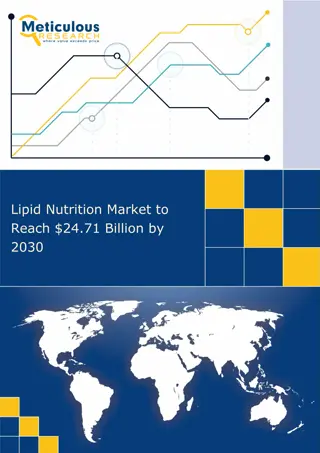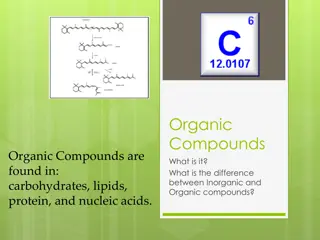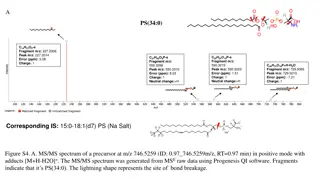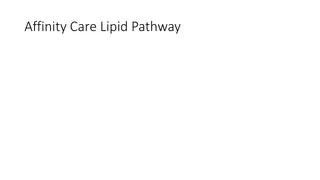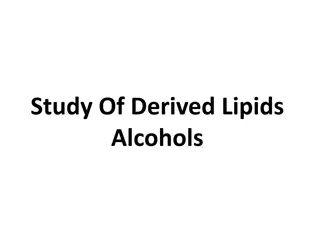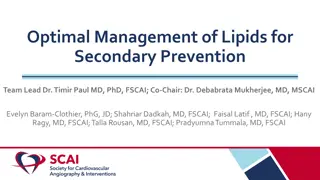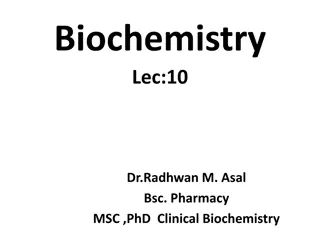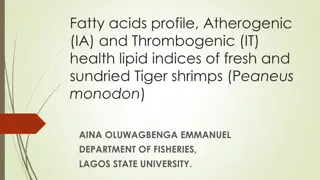Understanding Lipid Compounds and Their Physiological Significance
Explore the world of lipid compounds and their vital roles in the body, including serving as a major energy source, structural components of cell membranes, and key regulatory molecules. Learn about various types of lipids, such as fatty acids, phospholipids, and lipoproteins, and their relevance to clinical problems like obesity, atherosclerosis, and hypertension. Dive into the diversity of simple and complex lipids, and discover essential fatty acids crucial for health.
Download Presentation

Please find below an Image/Link to download the presentation.
The content on the website is provided AS IS for your information and personal use only. It may not be sold, licensed, or shared on other websites without obtaining consent from the author. Download presentation by click this link. If you encounter any issues during the download, it is possible that the publisher has removed the file from their server.
E N D
Presentation Transcript
Lipid Compounds of Physiological Significance By ReemSallam,MD,PhD
Objectives By the end of this lecture,students areexpected to: recognize various functions of lipid compounds relate lipid metabolismto specific clinical problems identify examples of lipid compounds of physiological importance recognize examples ofcomplex lipids,such as: Phospholipids Glycolipids Lipoproteins
Functions oflipidcompounds Majorenergy source for the body Structuralcomponent ofcellmembranes Important regulatorymolecules; examples: Fat-soluble vitamins Steroid hormones Prostaglandins Signalingmolecules;e.g. Inositol triphosphate (IP3)
Lipids andRelatedClinicalProblems Obesity Atherosclerosis Hypertension Coronary heart diseases
LipidCompounds Heterogeneous group Relatively water-insoluble (Ketone bodies are the exception) Soluble in non-polarsolvents
Simple Lipids: 1. Fatty acids 2. Ketone bodies 3 . Triacylglycerol 4. Cholesterol Complex Lipids: 1. Phospholipids 2. Lipoproteins 3. Glycolipids 1. 2. Lipid Compounds: Heterogeneous Group
FattyAcids Amphipathic: Both hydrophobic & hydrophilic parts
F Fa at tt ty yA Ac ci ids ds Chain length: oShort-chain &Medium-Chain e.g.Fatty acids in milk oLong-Chaine.g.Palmitic acid 16:0 oV ery long-chain e.g.Nervonic acid 24:1 Degree of saturation: oSaturated:No double bonds oUnsaturated: oMono- or poly-unsaturated oCis- or trans-formof double bond Essential fatty acids
EssentialFattyAcids 1. Linoleic acid,18:2(the precursor of arachidonic acid) 2. Linolenic acid,18:3 3. The precursor ofprostaglandins, Arachidonic acid 20:4, isalso considered essential fatty acid if linoleic acid isdeficient from diet
PlasmaFattyAcids Esterified form (~90%): In triacylglycerol, cholesterol ester, phospholipids (as part of lipoproteins) Free-form (unesterified) = Free FattyAcids (FFA): Transported in association with albumin
Triacylglycerols(TG) Storage formof lipids in adipose tissue Constitute ~ 90%of dietary lipids Composed of glycerol plus 3fatty acids T ransported in blood:in chylomicrons &in very low density lipoprotein (VLDL)
1. Water-soluble lipids 2. Increase in Diabetic Ketoacidosis (DKA) Ketone Bodies 1.Acetone 2.Acetoacetate 3. -Hydroxybutyrate
Phospholipids A. Glycerophospholipids Glycerol-containing phospholipids 1. Phosphatidylcholine (Lecithin) e.g., Surfactant (Dipalmitoylecithin) 2. Phosphatidyl inositol (signaling molecule) B. Sphingo-phospholipids: Sphingosine-containing phospholipids: e.g., sphingomyelin (Myelin sheath) (To be discussed with CNS Block)
Phospholipids: A. Glycerophospholipids e.g. of members: 1. Phosphatidylcholine (Lecithin) e.g., Surfactant (Dipalmitoyl lecithin) Parent Compound Phosphatidic acid
Cholesterol: Structure
OverviewandFunctionsofCholesterol MajorSterol of animal tissues Component of cell membranes Precursorfor: Bile acids & salts Vitamin D Steroid hormones: Mineralocorticoids Glucocorticoids Sex hormones e.g.,Aldosterone e.g., Cortisol e.g., Testosterone Estrogen & progesterone level in Associated Abnormally (Hypercholesterolemia): Atherosclerosis & CoronaryArtery Disease (CAD) high blood with
LipoproteinStructure Protein part:Apoproteins or apolipoproteins Abbreviations:Apo-A, B, C Functions: Structural and transport function Enzymatic function Ligands for receptors Lipid part: According to the type of lipoproteins Different lipid components in various combinations
Chylomicrons Very low density Lipoprotein (VLDL) Composition of Lipoproteins Low density Lipoprotein (LDL) High density Lipoprotein (HDL)
Ultracentrifugation of Lipoproteins
PlasmaLipoproteins Transport of Triacylglycerol (TG): Chylomicrons: VLDL: TG of dietary origin TG of endogenous synthesis Transport of Cholesterol : LDL: HDL: Mainly free cholesterol Mainly esterified cholesterol
T Tak ake eH Ho om me eM Me es ss sa ag ge e Lipids are heterogeneous group of compounds Lipids are relatively water-insoluble Simple lipids: FattyAcid, TG, Ketone bodies, Cholesterol Complex lipids: e.g., Phospholipids, Lipoproteins Lipids have important physiological functions Lipid disorders are the basis for common human diseases, namely obesity and atherosclerosis



